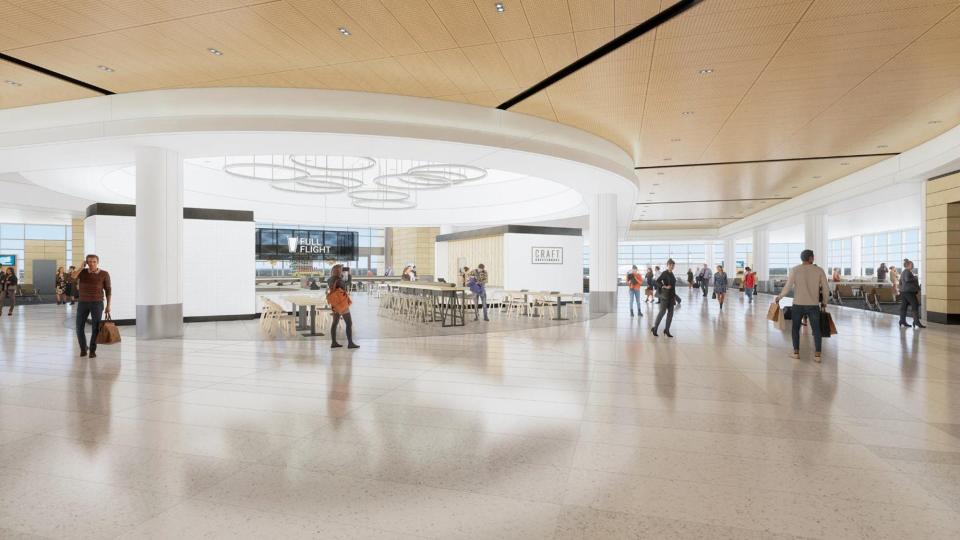After record passenger growth, Springfield-Branson National Airport plans for expansion
The Springfield-Branson National Airport is on track to have a record-breaking year this year, welcoming a total 1.3 million passengers with July being the busiest month in the history of the airport. As this growth continues, the airport will need to be adjusted and expanded, officials said.
Springfield City Council heard a presentation on the Airport Master Plan for the next 20 years on Tuesday afternoon. The presentation covered a future passenger terminal expansion, opportunities for an additional runway and ways to address parking needs.
Director of Aviation Brian Wieler called this one of the "most important" master plans the airport has ever had considering the rate of growth the airport has undergone this year and that is projected to continue in the following years.
Passenger terminal updates
The plan includes the extension of the commercial terminal via a "knuckle" and two prongs extending from the current concourse to the north to include more gates, passenger processing areas, restrooms, retail spaces and even a possible outdoor patio. This extension would likely come as the airport nears 2 million passengers a year, though it also depends on airline schedules, which can create peaks and set different trends in terms of gate utilization.
By creating this node, walking distances to the additional gates would be shorter than if the concourse was simply extended straight outward. It also allows the gates and aircrafts to be more spaced out, reducing congestion.

With the number of people visiting the airport growing, the demand for parking is also on the rise. Airport officials are suggesting that a multi-level parking garage with 1,800 spots should be built atop the current rental car lot. In addition, the plan notes that the area on the east side of the terminal, currently used for taxis and buses, is underutilized and could be a place for Lyft and Uber pickup and drop off.
The forecasted growth data will likely be reconsidered again next year because of how dynamic the industry has been. The updated data will allow the Airport Board to make more accurate decisions about parking and the needed timeline for commercial expansion.
"The decision of a parking garage is not insignificant. For me, that's a huge, significant capital investment," said Doug Gregory, aviation planning group manager with Crawford, Murphy and Tilly, the contractor selected to help create the plan. "So, making sure that demand is going to kind of meet those needs in the future is just as important."
Building in flexibility
Predicting growth and forecasting the future demand of airport facilities is difficult, particularly after the COVID-19 pandemic affected the market on a grand scale. But the plan addresses this uncertainty for the future with built-in flexibility and use of space.
The main possibility the plan addresses is the addition of a runway parallel to an existing one. Currently, the airport has two runways that cross over one another. The additional runway could become a necessity to address the need of passenger growth and provide resiliency in case the other runways cannot be operated.
While this runway is not expected to be needed within the 20-year span the plan covers, the airspace will be preserved to keep this as an option in the future. There is also space preserved that could be used for border patrol services if the airport ever expands to include international flights.
Who will pay for all of this?
The airport has an enterprise fund and works to generate its own revenue. But all these plans, despite stretching 20 years, will not be cheap.
Wieler said the airport has and will continue to aggressively pursue grants, although the terminal and parking expansions are expected to be funded through a bond initiative.
"We're only going to be able to move as fast as our funding sources allow," he said.
The airport wants to continue to attract airlines via their low operation costs, but this means revenue will have to come from other sectors. The plan identifies spaces nearby the airport that could be used for non-aeronautical uses like corporate campuses or hospitality developments.
More: Springfield City Council renames airport's Midfield Terminal after retiring Sen. Roy Blunt
General aviation is also a major revenue driver for the airport and expansions to that sector of the airport are included in the plan. Additionally, Wieler said general improvements can often be a result of working together with private entities. Overall, the airport makes money through various different sources but the need for upgrades will always surmount actual available funds.
"There's never enough money, the number of needs always outpaces the number of what we have the resources for," he said.
Federal funding will also be a factor in realizing these plans, hence the plan is a necessary portion in receiving that support. The plan will now be submitted to the Federal Aviation Administration for final feedback before it comes before City Council for formal approval and implementation.
Marta Mieze covers local government at the News-Leader. Contact her with tips at mmieze@news-leader.com.
This article originally appeared on Springfield News-Leader: Springfield-Branson National Airport prepares for more passengers

